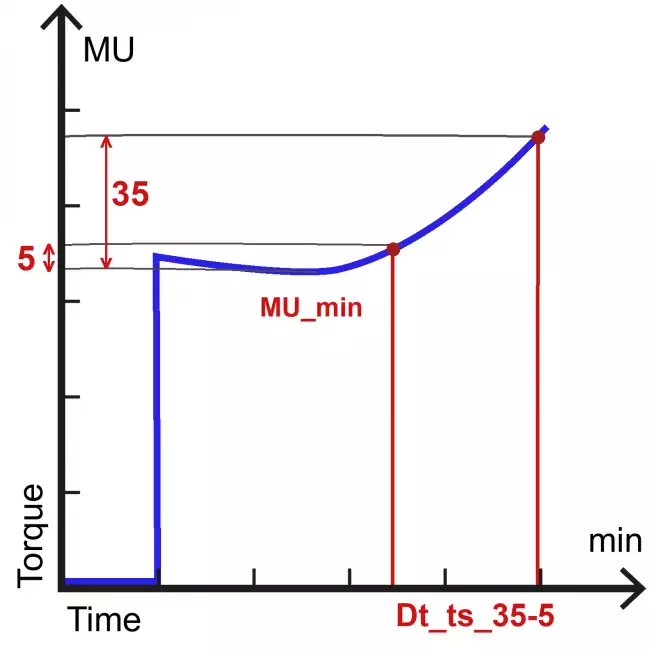MooneyCheck: Test Results
Below you can find the description of the test results produced by MooneyCheck software

Mooney Viscosity at set time
The calculation returns the Mooney Viscosity after the set test time. Standard test time includes 1 minute pre-heating time and 4 minutes test time.
REFERENCE STANDARD: ISO 289-1 / ASTM D 1646
UNIT: MU (Mooney units)
CALCULATION PARAMETERS:
Test Time: t
EXPRESSION:
ML (1+t) - Example ML (1+4)

Minimum Mooney Viscosity
The calculation returns the minimum value of Mooney Viscosity over the complete test time.
UNIT: MU (Mooney units)
EXPRESSION:
MU_min

Initial Mooney Viscosity
The calculation returns the Maximum Mooney viscosity at the beginning of test time.
UNIT: MU (Mooney units)
EXPRESSION:
MU_ini

Viscosity reduction Rate
The calculation returns the Slope of curve of the Viscosity vs Time at the set test time.
UNIT: MU (Mooney units)
PARAMETERS:
Test Time: t
EXPRESSION:
S (1+t) - Example S(1+12)

Delta Mooney Viscosity
Reference standard ISO 289-3
The calculation returns the difference between the Mooney viscosities recorded at running time t1 and t2.
UNIT: MU (mooney units)
PARAMETERS:
Test Time t1
Test Time t2
EXPRESSION:
Dt_MU_(t2-t1)

Scorch Time
OVERVIEW:
The pre-vulcanization characteristics provide a means of estimating how long compounded rubber can be maintained at high temperatures and remain processable.
REFERENCE STANDARD:
ISO 289-3 / ASTM D 1646
The calculation returns the time in minutes including warm-up time, for the viscosity to increase by a specified amount from the minimum value.
UNIT: mm:cc (minutes, minutes/100) or mm:ss (minutes, seconds)
PARAMETERS:
Torque Increase: MU
EXPRESSION:
ts_MU (example ts_35)

Scorch Index
The calculation returns the time needed for the viscosity to increase from the first to the second set values.
REFERENCE STANDARD: ASTM D 1646
UNIT: mm:cc (minutes, minutes/100) or mm:ss (minutes, seconds)
PARAMETERS:
Start Torque Value: ts1
Final Torque Value: ts2
EXPRESSION:
Dt_ts_(ts2-ts1) - Example: Dt_ts(35-5)

Mooney Stress-Relaxation Rate
OVERVIEW:
Stress Relaxation test consists of determining the decay of the Mooney torque immediately after the determination of the Mooney viscosity. After abruptly stopping the rotor at the end of the Mooney viscosity measurement, the decrease in torque is recorded as a function of time. The rate of change of the torque is evaluated over a short time interval.
REFERENCE STANDARD: ISO 289-4
CALCULATION:
The calculation returns the slope of the linear regression line of the log(torque) versus log(time) plot over a specified time interval after stopping the rotor at the end of a Mooney viscosity measurement. According to ISO Standard the regression is calculated between 1.6 and 5 seconds from rotor stop.
UNIT: Mu/sec
PARAMETERS:
Time for Start of Regression Calculation: t1
Time for Stop of Regression Calculation: t2
EXPRESSION:
a(MSR) t1_t2 - Example: a(MSR) 1.6_5.0

Mooney Stress-Relaxation Area
The calculation returns the area under the stress relaxation curve over a specified time interval after stopping the rotor at the end of a Mooney viscosity measurement.
REFERENCE STANDARD: ASTM D 1646
UNIT: Mu*sec
PARAMETERS:
Time for Start of the Calculation: t1
Time for Stop of the Calculation: t2
EXPRESSION:
A (t1_t2) - Example: A (1.6_5.0)

Gibitre Instruments
Via dell'industria, 18
Bergamo (Italy)
te. +39 035 461146
www.gibitre.it
info@gibitre.it
Copyright Gibitre Instruments
















